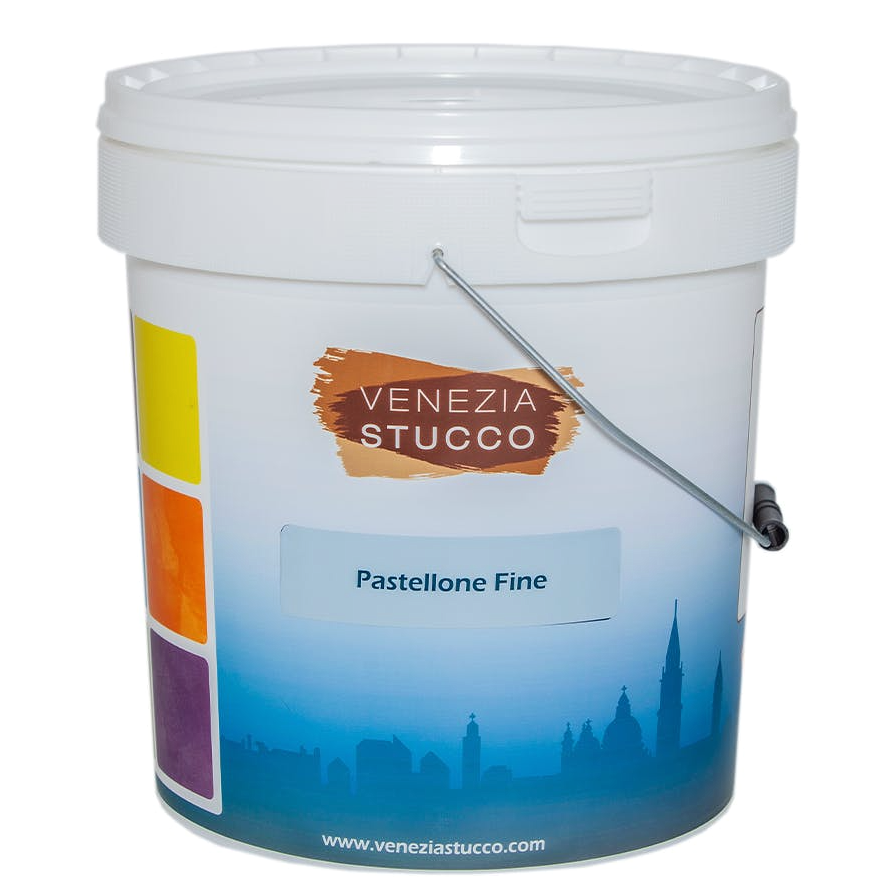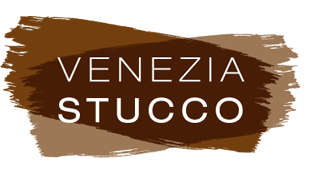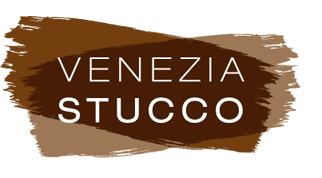Pastellone Fine, Pastellone Medium and Binder For Pastellone
Pastellone is a highly decorative traditional material used for floors or to unify walls and floors where you want to create a continuous, seamless surface. In the manufacturing of our Venezia Stucco materials, we attach great value to the quality of the materials, ease of application and a customized colouring system. The range of additives makes it possible to modify the characteristics of the products and vary the aesthetic effects of our marmorino.

Informations and use of Pastellone
Pastellone Fine and Pastellone Medium together with the Binder for Pastellone are used in interiors. Applicable on existent floor or over floor heating systems, is naturally anti-mould.
Colour
Ready to use in white, can be coloured with our colour system or customized for any requested colour.
Packaging
- Pastellone Fine (in powder form) kg 16 bucket
- Pastellone Medio (in powder form) kg 16 bucket
- Binder for Pastellone l 7,2 bucket
Composition
Powder of white cement, lime, selected marble and quartz powders. Various additives (less than 4%). It is moistened with the Binder for Pastellone, consisting of acrylic resin and fluidifying agents.
Application cycle
- Apply our Primer Normal diluted with 8 parts of water(applied by roller or brush) (roller or brush)
- 1 coat of Pastellone Medio diluted with the Binder for Pastellone (trowel) using more or less 1.2 kg per m²
- 2 coats of Pastellone Fine diluted with the Binder for Pastellone (by trowel) using about 1.1 k g per m².
Protection
Protect with transparent water based polyurethane Pastellone Varnish component A+B or Pastellone Wax
RELATED PRODUCTS
Protective and Auxiliary Products
(links to the products)
Pastellone Glossy Wax, Pastellone Satin Wax, Pastellone Matt Wax
Pastellone Varnish component A+B
Decorative Additives
(links to the products)
Terracotta for Veneziano Medio
Instructions for the application of Pastellone Fine, Medium and Binder
Application on the ideal substrate: plaster made cement and sand
A water-based primer, like our “Primer Normal”, is applied with a roller on a substrate free of dirt and grease.
Mix the material for the first coat, the Pastellone Medium with enough BINDER additive to make the mixture dense enough to apply easily with a metal trowel. Normally you need about 470 ml. of BINDER for 1 kg. of Pastellone powder.
Spread the first coat evenly over the entire surface, finishing, obviously, at doorway. You will need approximately 0,9 / 1,1 kg of material per 1 square meter. Let it dry until the next day.
For the second coat you use the
Pastellone Fine.
If you have to add color to the material there are three possibilities:
1) Color the material with powder colorants before adding the BINDER. You have to figure out how much colorant to add to each container first which involves a long process to establish how much colorant is needed to obtain the color you want.
2) Color the white material after you have mixed it with the BINDER. You still have to do color tests beforehand to be sure of the exact weight of liquid colorant you will use.
In all the cases, the colorant must be one which is resistant to the alkaline in the cement.
Mix up the enough material for the second coat (0,7/1,1 kg. of powder per square meter) and using a metal trowel, start applying it. Have a clear plan of how you are going to apply it in 40-50 cm. strips, beginning at the point farthest from the door.
- Be careful to apply it uniformly and smoothly -
After you finish applying the second coat, you’ll have time to prepare the material for the third coat. It is difficult to know how long to wait before applying the third coat because it depends a great deal on the air temperature and humidity. In general, the moment is right when you can comfortably step on it which could be after 25 minutes or up to an hour. It is recommended to go barefoot or wear socks that won’t leave their imprint on the material.
Apply the third coat with the metal trowel as you would a normal marmorino, but without press too much. Complete the whole floor and then, when you can step on it, come back using a spray bottle with water and working in small areas spray the water and make smooth using both a metal trowel and a plastic trowel. The metal trowel can leave dark marks like it does when you scrape metal over a hard surface . This is more visible with lighter colors. Because of this you have to use the the plastic trowel to finish smoothing it out. You will notice that on a floor, you don’t need to finish it as smooth and polished as you would on a wall. Besides it’s not possible to return to polish it after 10 or 15 minutes, as you do on a wall.
The day after the floor can be sanded with a sander machine. This treatment is done to make the surface more smooth and to increase the movement of dark and light marks. A P 180, P120 or P100 paper can be used. The sand paper do not scratch the surface since it is very hard, but just polish it.
NOTE: VARIATION OF APPLICATION
The easiest and fast way to make this finish requires the use of a sanding machine with disks of metallic net (mesh). Apply the last coat without pressing too much, just having care to make the floor quite even, Than, the day after, sand all the surface with a sanding machine with the metallic mesh P100. To sand with the metallic disk helps make the surface smooth ( we do not use the normal disk of sanding paper since it doesn't give a good result like the metallic mesh) also if the last coat was not very well done and uniforms the surface. This way of application reduces the time of work and gives a more even finish.
If you want to have more movement you can apply one or more layers of a coloured solution: prepare our primer diluted 1 part of primer and 15 of water. Tint it in the needed tone and, after made proper test, apply this solution all over the floor using sponges, normal cloths or the special cloth tool to apply the floor wax. In this way where you leave more tinted solution you get more dark getting “shadows of color”. Please, be careful to make tests before tinting the floor.
Create an environment with the right humidity because the slower the material dries, the stronger it becomes. The floor shouldn’t be walked on for several hours and in any case should be protected until you apply the final protection. Without the final protection, the floor can always be easily stained.
After 2 days (the longer, the better), you can apply the final treatment which can be done in two ways:
1. With the application of a dual component polyurethane for which we can give you application instructions. This is usually applied with a roller in two coats leaving at least 8 hours between on layer and the next. When it is completely dry you can apply the final treatment with the Floor wax that can be Matt, Satin or Glossy. The wax treatment has the purpose of create a consumption layer that can be reapplied easily and also to get the desired level of gloss. To get very glossy you can polish the glossy wax with the special buffering tool that is applied under the sanding machine, or starting using a glossy PU varnish and the glossy wax. Note that the wax is not strictly necessary treatment but it is suggested and improves the water repellency. The wax can be diluted maximum 10% and has to be applied in a very thin layer with a yield of 1 liter 30-40 square meters.
2. With linseed oil. Pour it on the floor and spread with a soft, absorbent cloth. This will be done two more times, allowing the first coat to dry at least 12 hours. Note that to use linseed oil your floor has to be very dry since the presence of water could causes modification of the oil, the same process which happens when we make soap from oil!! It means white marks on the floor.
Note:
• If you are working on a new concrete substrate, be sure that it is at least a month old and that it is completely dry. It’s possible for cracks to appear in new concrete the first 2-3 weeks after laying the concrete.
• During application, the material can be directly poured from the bucket onto the floor and then spread with a trowel.
• During application, it is useful to have a light source close to and parallel to the floor. Be careful, however, that this doesn’t dry out the material too much before applying the third coat.
• This material can be used to cover concrete bathtubs and shower stall walls as a substrate. Naturally, they would have to be well-treated with good waterproofing or our P.U. varnish.
• Before the final treatment of the floor, small imperfections can be removed using sandpaper.
• Keep in mind that when preparing the colour that it darkens considerable after applying the oil, which we call the “wet look”.
• Your customer should know that dropping heavy objects on the surface can cause small dents, exactly as happens with wood flooring.
• It is possible to do touch-ups when necessary. To do this, we advise keeping some of the powder coloured material in a well-sealed container. Use a container which is just big enough so the material is exposed to little air. Doing this should allow you to keep the material ready to use for many years.
• If the substrate is cracked you have to substantiate that they are cracks due to the curing process and not due to settlement. If the latter is the case, your customer should be advised that they will responsible for any reappearance of cracks. Any way the application of a mesh fixed to the substrate using the Marmorino for floor gives great result against cracks and by experience we can say that it works almost always so we strongly suggest to use it although we cannot give a guarantee of success.
• If you have to work in two adjacent rooms, it is advisable to create a natural break at the doorways. You can’t, in fact, work in 2 or 3 rooms at a time without having breaks. One way to deal with this is to put a strip of metal (aluminum, steel or brass) into the concrete (screed) substrate which will act as a divider. This strip of metal should rise above the surface of the concrete 1.5 - 2 mm. (the eventual thickness of your marmorino coating).
Suggestions for the Application of lime plasters.
These are suggestions to always keep in mind when applying Marmorino, Intonachino and other lime-based products.
A lime plaster (and also cement) changes color depending on its drying time. However, the general rule of thumb is that the slower it dries, the darker the resulting color. With marmorino, a darker tone is also related to how much pressure is applied during the polishing phase.
It is customary to recommend applying lime plasters at a minimum ambient temperature of 5°C (41°F), but experience has shown that if you want to avoid color differences, the minimum temperature should be higher.
This is also linked to two other factors: the relative humidity of the air which determines drying time and, consequently, the tone of the color, and finally, and just as important, the absorption of the substrate.
Therefore, when applying lime plaster, you have to take into account these three factors.It is difficult to give precise guidelines. It depends a lot on the experience of the technician, who in any case has to keep in mind these factors and understand the characteristics of the materials.
For the substrate: the ideal plaster is one which has the same amount of absorption over its entire surface. If there are areas of concrete under the plaster (for example, around windows or along the area where two floors of a building meet), it’s possible that with a thin layer of plaster, there will be different amounts of absorption. If the temperature and humidity are good enough to ensure a rapid absorption, these differences in absorption rates won’t affect the color. But if there are low temperatures or high humidity, the areas which absorb more slowly will become darker.
It is always recommended to apply primer first. This is not really enough to guarantee an equal absorption rate over the entire area, but is always a good idea. The quality of the primer is especially important when conditions are at a minimum.
Remember that only an experienced technician can guarantee good results. However, if there is one rule, independent of the absorption of the substrate, the humidity should be about 84% and the temperature should not go below 7°C (45°F). Obviously, if the humidity goes up, the temperature should go down.
Always keep in mind that the temperature and humidity should stay within these recommended limits for the entire drying time. The technician could forget that if he finishes applying the material in the afternoon, it could undergo colder temperatures during the night which would push it beyond the recommended limits before drying is complete.
One last thing to remember is that the wind can also play a role and can help to accelerate drying time.
Naturally if the substrate has a uniform absorption and you do all the work on one side of the building on the same day, you can go to the edge of the recommended limits since a small change in color from one side to another won’t be visible.
A brief history of lime as building material
Lime has been used for nearly two thousand years in the construction of foundations, floors and especially in particularly humid environments such as coatings of aqueducts and water pipes. Alongside these structural works it has been used for wall coverings such as mortars, interior and exterior plasters and in various types of decorative applications.
First, a brief mention of lime mortar chemistry, the production of which is basically a three-step process:
- Calcination: When limestone/chalk (calcium carbonate) is burnt in the kiln it turns into quicklime (calcium oxide) and releases carbon dioxide.
- Hydration: Water is added to quicklime/burnt lime to produce hydrated lime (calcium hydroxide). Carbonation: Over the lifetime of lime products, carbon dioxide is gradually re-absorbed by lime from the air, which is also known as “re-carbonation”, as, chemically, this begins to turn the lime back into calcium carbonate, essentially the opposite of the calcining/burning process.
The beginning of the use of
lime in mortars is unclear, however in 4000 BC. the Egyptians discovered that limestone, when burned and combined with water, produced a material that hardened with age. The first documented use of this was when the pyramids were plastered with a lime-based plaster.
An extensive use of
lime mortar occurred when it was adopted by the Greeks and later by the Romans around the first millennium BC. It is not clear when the Romans started using lime mortar, but around 150 BC. it was common practice. The Romans developed a hydraulic-setting lime mortar with the addition of crushed
ceramics,
crushed brick (coccio pesto) or volcanic ash (pozzolana -pozzolanic ash) within the mortar mix.
The earliest most important references to lime mortar come from Vitruvius' De Architectura, written around 25 BC.
Vitruvius, specifies a ratio of 1 part lime and 3 parts pozzolan for the lime mortar used in buildings and a 1: 2 ratio of lime and pozzolan for underwater works.
Lime mortar continued to be used from the Roman Empire until about the 19th century, where it was superseded in use by Portland cement mortars.
But, although technology has developed new construction products,
lime mortar is still widely used as a greener construction option than concrete. For both modern and historic homes, it offers a number of advantages that make it highly competitive over alternatives.
Among the most important advantages we have:
-Workability:
Lime mortar has great plasticity. This makes it easy to work with and suitable for modelling in decorative environments.
-Does not separate:
Lime is an excellent
binder. This prevents the mortar from crumbling over time, ensuring its resistance to bad weather.
-Lime is also used to repair traditional buildings that were originally built with lime mortars, this is because lime allows for greater movement without cracking or damaging the original masonry -Lime can also be a great solution to moisture problems as it absorbs water and releases it reducing the chances of water getting trapped and damaging the building.


